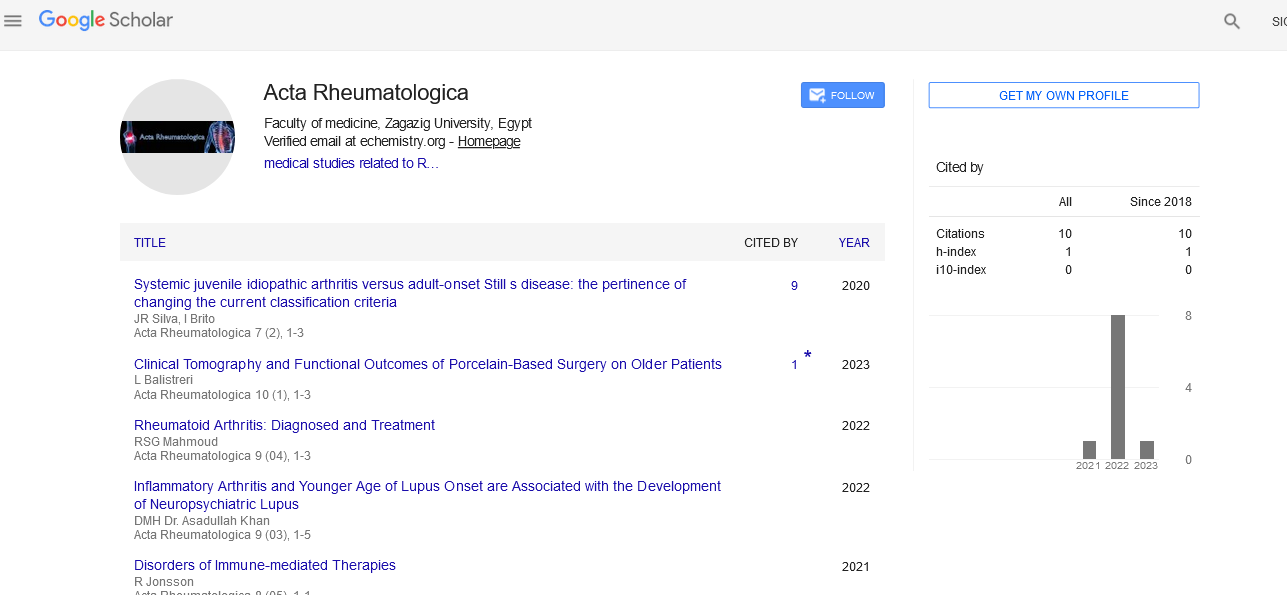Cherdak Manava*
TU Institute of Medicine, Maharajgunj Nursing Campus, Nepal
- *Corresponding Author:
- Cherdak Manava
TU Institute of Medicine,
Maharajgunj Nursing Campus, Nepal
E-mail: reynolds.ev45@yahoomail.com
Received Date: October 16, 2021; Accepted Date: October 21, 2021; Published Date: October 26, 2021
Citation: Manava C (2021) Editorial Note on Chronic Knee Pain Acupuncture. Acta Rheuma. Vol.8 No.5:4
Editorial
Knee pain affects around a quarter of adults over the age of 55, and in about half of these, it is severe enough to limit typical daily activities. After particular illnesses such as inflammatory arthritis are ruled out, much of this discomfort is classified as 'osteoarthritis' (OA). The clinical problem of OA encompasses a large number of older persons with knee discomfort, as well as a subset of patients who exhibit radiographic abnormalities in the relevant joints as well as a clinical condition of pain, stiffness, and restricted movement. The literature is divided on the use of radiography and the necessity of distinguishing the disease process of OA from the syndrome of musculoskeletal pain and dysfunction. Pain reduction and better mobility have been regarded as the top treatment priority by both people with arthritis and professionals.
Pharmacological therapy have limited appeal: the effects of nonsteroidal anti-inflammatory medicines are minor and shortlived, and their use is accompanied with major adverse effects such as bleeding and ulceration. Cyclooxygenase-2 inhibitors were introduced in the goal of reducing the incidence of gastrointestinal side effects; however they appear to raise the risk of cardiovascular disease instead.
Chronic knee pain affects many people over the age of 50 and is the most prevalent reason for older adults to contact their family physicians. It is usually caused by osteoarthritis and is associated with a loss of physical function. Nonpharmacological techniques are critical in the treatment of chronic knee pain. Complementary and alternative medicine is frequently used by patients suffering from joint pain and arthritis. Acupuncture is the most widely used alternative medical system, with its popularity growing over time. Laser acupuncture (low-intensity laser therapy to acupuncture sites), while typically done with needles, is a noninvasive alternative with evidence of efficacy in specific pain problems. The effectiveness of laser acupuncture in comparison to needle acupuncture is uncertain. Preliminary evidence suggests that laser may be more effective than needles for treating myofascial trigger points.
A meta-analysis supports the use of needle acupuncture to treat osteoarthritis pain. Acupuncture effect sizes were substantially smaller when compared to sham needles rather than no-acupuncture controls, suggesting that performance bias, response bias, or both may have influenced outcomes. Because patients have different acupuncture beliefs, and positive views regarding acupuncture are regularly connected with significantly superior treatment outcomes, traditional clinical trial results may be influenced by recruitment bias. Non-pharmacological therapies for knee arthritis are thus becoming more appealing and are included in current treatment recommendations. One of the most often used of these is acupuncture, which may be considered a sort of sensory stimulation, and its use for pain relief is supported by evidence of biological processes underlying its benefits. However, there has been insufficient evidence of its clinical effectiveness to formally explore integrating acupuncture into the health service until recently.
A recent assessment of seven trials of acupuncture for knee pain associated with OA concluded that acupuncture may play a role in treatment, but its findings were restricted by the low quality of the majority of research. Several more trials have recently been published, so it is now appropriate to review whether acupuncture decreases pain and improves physical function in individuals with chronic knee pain when compared to placebo/sham treatment, no treatment, and conventional treatment.
41360





